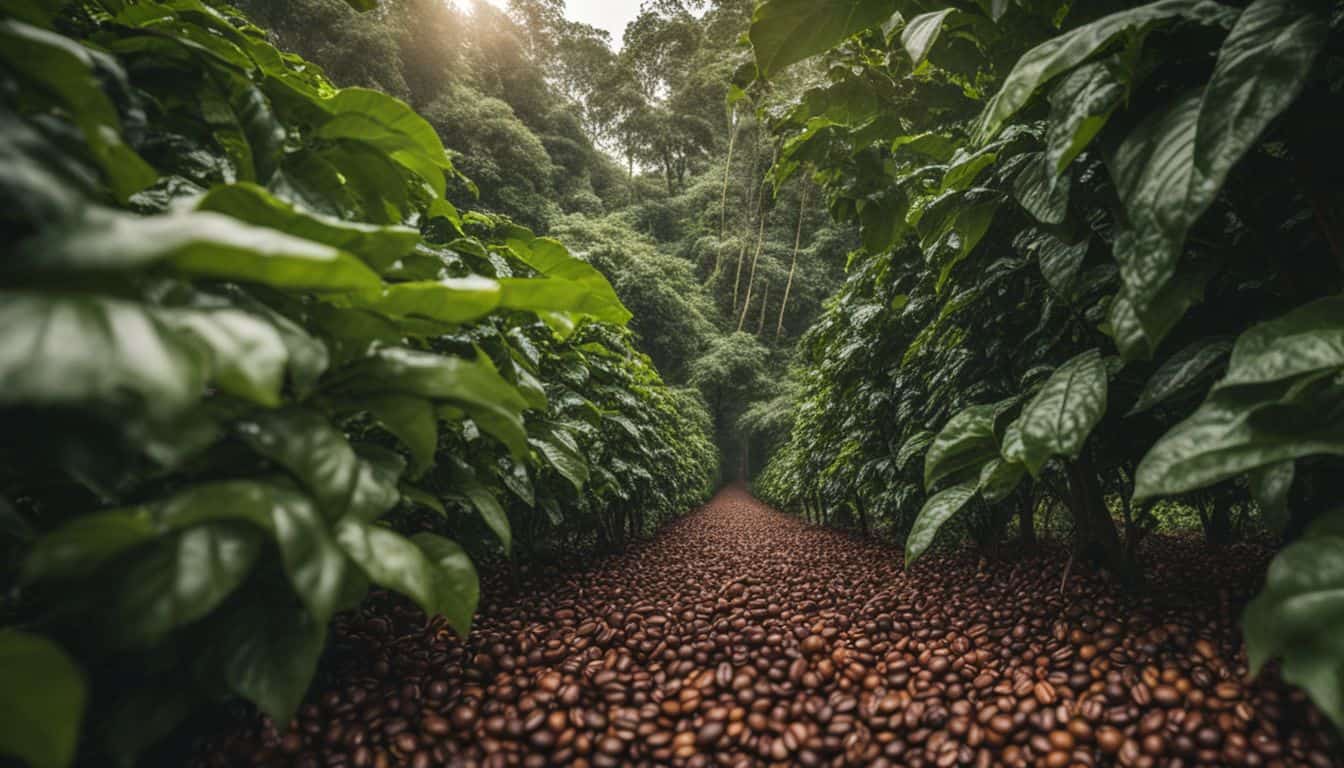From the scent of freshly brewed coffee to its taste dancing on our tongues, we all love the experience. But did you know coffee has what economists call an ‘inelastic price elasticity‘? That’s right! Based on extensive research and studies, a slight increase in coffee prices doesn’t cause a massive decrease in demand as you might expect. So, is coffee price inelastic or elastic?
In this article, we’ll delve deeper into why coffee prices effectively defy economic logic by examining factors such as availability, cultural preferences and other key market dynamics.
Get ready to uncover the surprising world of coffee economics!
Key Takeaways
- Coffee prices are generally inelastic, meaning that changes in price have minimal impact on consumer demand.
- Factors such as availability, substitutes, income levels, and cultural preferences influence the elasticity of coffee demand.
- In the short run, coffee demand tends to be less responsive to price changes, while in the long run it becomes more elastic as consumers have time to adjust their preferences.
Understanding Coffee Demand: Elastic or Inelastic?
Coffee demand elasticity refers to the degree of responsiveness of coffee consumption to changes in its price. Factors such as availability, substitutes, income levels, and cultural preferences influence the elasticity of coffee demand.
Definition of elasticity
Elasticity is a key word we need to know. It tells us how much the amount of something changes when its price goes up or down. For example, if the price of a pen goes up and people stop buying it, then pens have high elasticity.
But, if the price of bread doubles and folks still buy it because they need to eat, then bread has low elasticity. In short, goods with high elasticity see big sales changes when prices shift.
Low elastic goods? Not so much change.
When talking about coffee, we use this same idea. We want to know how much the demand for coffee will change as its price does too.
Factors influencing coffee demand elasticity
Several factors influence the demand elasticity of coffee. These factors help determine how sensitive coffee consumption is to price changes. Here are some key factors:
- Availability and substitutes: The availability of coffee and the presence of substitutes can affect its demand elasticity. If there are few substitutes available or if coffee is not readily accessible, consumers may be less likely to change their consumption habits in response to price changes.
- Income levels: The income levels of consumers also play a role in determining the demand elasticity of coffee. Coffee is considered a necessity for many people, regardless of their income level. This means that changes in income have minimal impact on demand, resulting in an inelastic response.
- Cultural preferences: Cultural preferences and habits surrounding coffee consumption can also influence its demand elasticity. In some cultures, coffee is an integral part of daily life and traditions, leading to a more inelastic demand for the beverage.
- Time period: The time period under consideration is another important factor in determining the demand elasticity of coffee. In the short run, consumers may be less likely to change their consumption patterns due to price changes, resulting in an inelastic demand. However, over a longer time period, consumers may have more flexibility to adjust their behavior, making the demand for coffee more elastic.
Factors Affecting the Price Elasticity of Coffee
Factors affecting the price elasticity of coffee include availability and substitutes, income levels, and cultural preferences.
Availability and substitutes
When it comes to coffee, availability and substitutes play a role in its price elasticity. Coffee is generally widely available, which means that people can easily find it and meet their needs.
This contributes to the inelastic demand for coffee because even if the price increases, people are still likely to continue buying it. Additionally, there aren’t many good substitutes for coffee that can match its taste and benefits.
Therefore, even if the price goes up or other options become available, most coffee enthusiasts will still choose to stick with their beloved beverage.
Income levels
Income levels have a minimal impact on the demand for coffee. Coffee is considered a necessity good, which means that people tend to buy it regardless of their income. This is because coffee is relatively affordable and widely available.
Even if someone’s income increases or decreases, they are unlikely to significantly change their coffee consumption habits. Therefore, changes in income do not have a significant effect on the demand for coffee.
Cultural preferences
Different cultures have their own unique preferences when it comes to coffee. In some countries, people enjoy strong and bold flavors, while in others, they prefer lighter and milder options.
Cultural traditions also play a role in coffee preferences, such as the practice of serving coffee with specific foods or during certain times of the day. For example, in Italy, espresso is a popular choice and is often enjoyed after meals.
Understanding these cultural preferences is important for companies that want to cater to different markets and expand their customer base. By offering a variety of coffee options that align with cultural tastes, businesses can meet the demands of consumers around the world.
Price Elasticity of Demand for Coffee
The price elasticity of coffee demand varies depending on the time period and the magnitude of the price change.
Short-term vs. long-term elasticity
In the short run, the demand for coffee tends to be less responsive to price changes, meaning it is inelastic. This is because people are often loyal to their favorite coffee brands and don’t easily switch to substitutes.
However, coffee becomes more elastic in the long run as consumers have time to adjust their preferences and find alternative options. So, while immediate price changes may not dramatically impact coffee consumption, people may become more sensitive to price fluctuations and make different choices over time.
How price changes impact coffee demand
When the price of coffee changes, it can have an impact on the demand for coffee. This is because consumers may be sensitive to price fluctuations and adjust their purchasing behavior accordingly.
However, the extent to which price changes affect coffee demand depends on various factors such as availability of substitutes, income levels, and cultural preferences. In the short run, coffee demand tends to be inelastic, meaning that a change in price has a relatively small effect on quantity demanded.
But in the long run, coffee demand becomes more elastic and responsive to price changes. Overall, understanding how price changes impact coffee demand is crucial for businesses and policymakers in order to effectively manage supply and meet consumer needs.

The Inelasticity of Coffee Prices
Coffee prices have shown to be largely inelastic, meaning that changes in price have minimal impact on the quantity demanded by consumers.
Reasons behind coffee’s inelastic demand
There are several reasons why coffee has an inelastic demand. One reason is that coffee is widely available and meets the needs of most coffee buyers. This means that even if the price of coffee increases, people still tend to buy it because they consider it a necessity.
Another reason for its inelastic demand is that coffee beans have a relatively inelastic demand, meaning that there is only a small change in the quantity demanded when the price changes.
Additionally, studies have shown that the price elasticity of demand for coffee is relatively low, indicating that changes in price have less impact on consumer behavior compared to other goods.
Relationship between supply and demand
When it comes to coffee, the relationship between supply and demand is crucial. The availability of coffee beans and how many people want to buy them directly affects the price. Coffee has an inelastic demand because even if prices go up, people still need their daily cup of joe.
This means that changes in price don’t have a huge impact on how much coffee is consumed. It’s also important to consider the time period when looking at supply and demand for coffee.
In the short run, demand tends to be less elastic, but over time, it becomes more elastic as consumers may look for alternatives or adjust their consumption habits. Overall, understanding the relationship between supply and demand helps us understand why coffee prices fluctuate and how they impact our favorite beverage.
Conclusion: Is Coffee Price Inelastic or Elastic?
In conclusion, the price of coffee is generally inelastic. This means that changes in price have a minimal impact on demand. Coffee is widely available and meets the needs of most buyers, making it a necessity good with relatively low income elasticity.
Understanding the price elasticity of coffee is crucial for understanding market dynamics and pricing strategies in the coffee industry.
Is an Americano Coffee Bitter or Sweet?
The intriguing world of coffee aficionados has its fair share of debates, and the question of whether an Americano coffee is bitter or sweet is no exception. Delving into americano flavors revealed, it becomes clear that its taste profile depends on personal preference and the coffee beans used. While some may find it bitter due to the strong espresso base, others embrace its smooth and subtle sweetness, with hints of caramel and cocoa.
FAQs on Is Coffee Price Inelastic Or Elastic
1. Is coffee price inelastic or elastic?
Coffee price is generally considered to be elastic, meaning that changes in price have a significant impact on the quantity demanded by consumers.
2. What does it mean for coffee price to be elastic?
When coffee price is elastic, it means that even small changes in price can cause a relatively large change in the quantity of coffee demanded by consumers.
3. Why is coffee price considered to be elastic?
Coffee is a product with many alternatives and substitutes available, such as tea or other beverages. This makes consumers more responsive to changes in its price and willing to switch to cheaper options if the price increases significantly.
4. How does elasticity impact the coffee market?
The elasticity of coffee prices affects both producers and consumers. Producers need to carefully consider pricing strategies as demand may drop significantly with even a slight increase in prices, while consumers have the opportunity to explore different brands or types of beverages if they find their preferred option too expensive.





Leave a Reply